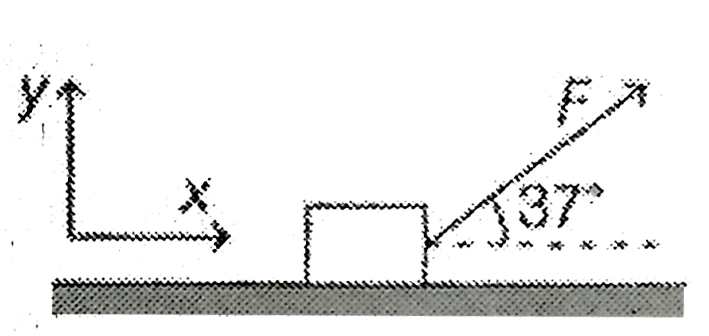Given F=(a/t)+bt2 where F denotes force and t time. The diamensions of a and b are respectively:
(a)[MLT−1]and[MLT−4]
(b)[LT−1]and[T−2]
(c)[T]and[T−2]
(d)[LT−2and[T−2]
The correct Answer is:C
To solve the problem of finding the dimensions of constants a and b in the equation F=at+bt2, we will follow these steps:
Step 1: Identify the dimensions of force F
Force F can be expressed in terms of mass m and acceleration a:
F=m⋅a
Acceleration a has dimensions of length per time squared, which can be expressed as:
a=LT2
Thus, the dimensions of force F are:
(F)=(m)⋅(a)=(M)⋅(LT2)=(MLT−2)
Step 2: Find the dimensions of a
From the equation F=at+bt2, we can isolate a:
at=F−bt2
For the term at to have the same dimensions as F, we can express the dimensions of a:
(at)=(F)
This means:
(a)(T)=(MLT−2)
Rearranging gives:
(a)=(MLT−2)⋅(T)=(MLT−1)
Step 3: Find the dimensions of b
Now, we analyze the term bt2:
bt2=F
Thus, we can express the dimensions of b:
(b)⋅(T2)=(F)
This implies:
(b)=(F)(T2)=(MLT−2)(T2)=(MLT−4)
Summary of Dimensions
- The dimensions of a are:
(a)=(MLT−1)
- The dimensions of b are:
(b)=(MLT−4)
Final Answer
The dimensions of a and b are respectively:
- a:(MLT−1)
- b:(MLT−4)
Force F can be expressed in terms of mass m and acceleration a:
F=m⋅a
Acceleration a has dimensions of length per time squared, which can be expressed as:
a=LT2
Thus, the dimensions of force F are:
(F)=(m)⋅(a)=(M)⋅(LT2)=(MLT−2)
From the equation F=at+bt2, we can isolate a:
at=F−bt2
For the term at to have the same dimensions as F, we can express the dimensions of a:
(at)=(F)
This means:
(a)(T)=(MLT−2)
Rearranging gives:
(a)=(MLT−2)⋅(T)=(MLT−1)
Now, we analyze the term bt2:
bt2=F
Thus, we can express the dimensions of b:
(b)⋅(T2)=(F)
This implies:
(b)=(F)(T2)=(MLT−2)(T2)=(MLT−4)
- The dimensions of a are:
(a)=(MLT−1)
- The dimensions of b are:
(b)=(MLT−4)
The dimensions of a and b are respectively:
- a:(MLT−1)
- b:(MLT−4)
Topper's Solved these Questions
- UNITS, MEASUREMENTS & ERRORSBOOK - VMC MODULES ENGLISHCHAPTER - UNITS, MEASUREMENTS & ERRORSEXERCISE - IN - CHAPTER EXERCISE - B
10 Videos
- UNITS, MEASUREMENTS & ERRORSBOOK - VMC MODULES ENGLISHCHAPTER - UNITS, MEASUREMENTS & ERRORSEXERCISE - PRACTICE EXERCISE - 3
3 Videos
- SYSTEM OF PARTICLES AND ROTATIONAL MOTIONBOOK - VMC MODULES ENGLISHCHAPTER - SYSTEM OF PARTICLES AND ROTATIONAL MOTIONEXERCISE - IMPECCABLE
56 Videos
- WAVE MOTIONBOOK - VMC MODULES ENGLISHCHAPTER - WAVE MOTIONEXERCISE - JEE ADVANCED ARCHIVE LEVEL 2 (TRUE FALSE TYPE)
4 Videos
Similar Questions
Knowledge Check
A force F is given by F=at+bt2 , where t is time . What are the dimensions of aandb?
A[MLT−3]and[MLT−4]B[MLT−4]and[MLT−3]C[MLT−1]and[MLT−2]D[MLT−2]and[MLT0]
Velocity v is given by v=at2+bt+c, where t is time. What are the dimensions of a,bandc respectively?
View SolutionA force F is given by F=at+bt2 , where t is time . What are the dimensions of aandb?
View SolutionGiven that the displacement of a particle x=A2sin2(Kt), where 't' denotes the time. The dimension of K is same as that of :
View SolutionForce acting on a particle is given by F=A−xBt, where x is in metre and t is in seconds. The dimensions of B is -
View SolutionForce is given by the expression F = A cos (Bx) + C cos (Dt), where x is displacement and t is time. The dimension of DB is same as that of
View SolutionForce on a particle in one-dimensional motion is given by F=Av+Bt+CxAt+D, where F= force, v= speed, t= time, x= position and A, B, C and D are constants. Dimension of C will be-
View SolutionA 1.5 kg block placed on a frictless orizontal floor is pulled by a force F Direction of the force is unchanged and its magnitude is incrcresaed with time according to the equation F =0.5 t n where t denotes time in second . Which of the following is /are correct for subsequunt motion after t=0 s? [g=10m/s2]

View Solution
